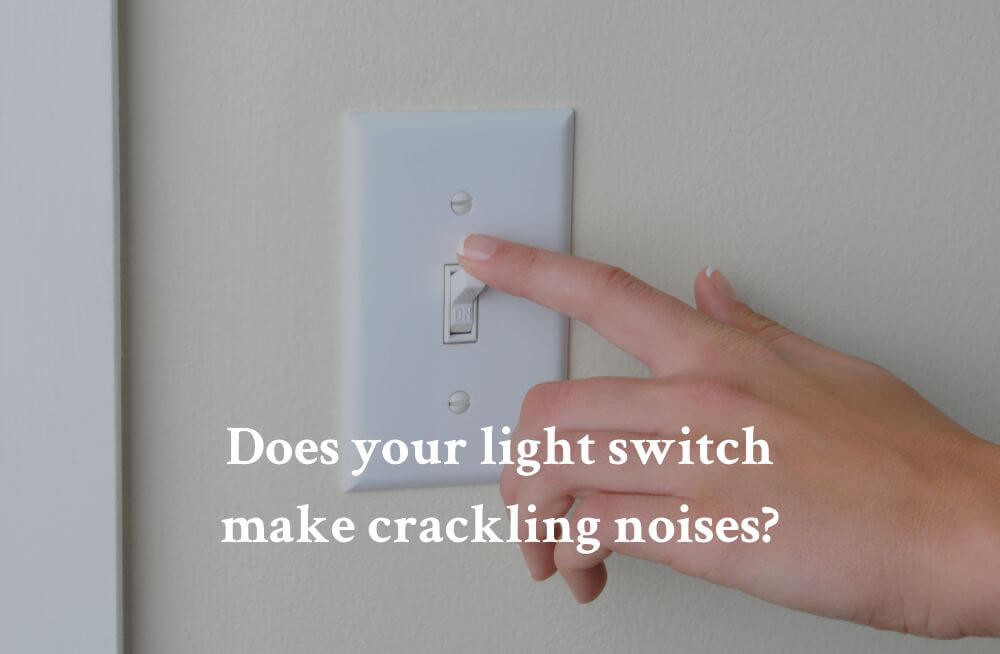What Do I Do If My Light Switch Makes Crackling Sounds When I Turn It On?
Snapping, crackling, and popping aren’t the normal sounds we should hear when we turn on a light switch. If that’s what you hear when you flip on your light switch, chances are, your switch needs replacing. Keep reading to find out what you should do if your light switch is beginning to sound like your breakfast cereal.

How Does a Standard Light Switch Work?
Electricity powers lights and other appliances with a continual flow of current. Your light switch is composed of two terminals. If the toggle is moved to the “on” position, the power supply wire – the black wire – will connect the two terminals, which lets the electricity flow through the light. When the light is turned off, you’re simply interrupting the flow of electricity. When you flip the toggle to the “off” position, the connection between the terminals is opened, stopping the flow of electricity.
So Why Does My Light Switch Make That Crackling Sound When I Turn It On?
The flow of electricity generates heat. This heat, however, is contained in the insulated wires. If the electricity escapes from the wiring, it can cause heat to build up quickly, creating a fire hazard. Faulty or loose connections anywhere in your electric circuit may cause arcing as the current tries to jump over the gaps. Most light switches are used daily. Often multiple times a day. This causes the components in the switch to wear down or even malfunction as time passes. If the switch is no longer making proper contact between the two terminals when the light is on, the power flow will be intermittent. This may cause the current to arc, creating the hissing or crackling sound that you hear. If you notice these sounds or if you hear the loud pop mentioned above from your light switch, replacing the switch is the best option.
How To Replace a Standard Light Switch?
Replacing a light switch is not overly complicated, but if you are not familiar with these types of repairs, it’s best to leave it to a professional. If you’re comfortable replacing the switch yourself, follow these steps:
- Before doing any type of electrical work, always turn off the power to the circuit at the breaker box. Use a multimeter or non-contact voltage tester at the switch to verify that the power is off.
- Use a screwdriver to remove the switch plate.
- Remove the screws that attach the switch to the wall. Gently pull the switch out and inspect the wiring.
- Older switches will have wires that loop around the terminal screws on the side of the switch. Free the wires by loosening the screws, if this is the case.
- Newer switches, known as “back-wired” or “push-in” switches, have wires that attach through holes in the back of the switch rather than the terminal screws. To remove these wires, insert the flat blade of a small screwdriver into the slots beneath the holes (where the wires enter the housing) while gently pulling the wires loose. Note: If wires are not color-coded, be sure to keep track of which wire goes where. Attach temporary labels, if necessary.
- The “hot” wire (usually black or red) attaches to the brass screw or enters the hole on the same side as the brass screw.
- The neutral wire (white) attaches to the silver screw or enters the corresponding hole.
- The ground wire (green or bare copper) may be attached to the green terminal screw on the switch or it may be attached directly to a screw on the electrical box. If it’s attached to the switch, unscrew it.
- You’ll need about a half-inch of exposed wire on both the hot and neutral wires. Use a wire stripper, if necessary, to remove the wire casing from the ends.
- Pay attention to the on/off labels on the new switch to ensure proper orientation. Attach the hot wire to the new switch by twisting the exposed wire into a clockwise loop around the brass screw and tightening the screw. (The tip of the wire should be pointing away from the room.) If you are installing a back-wired switch, simply insert the wire through the appropriate hole (the one on the same side as the brass screw.)
- Follow the previous step to attach the neutral wire to the new switch, attaching to the silver screw, or guiding through the appropriate hole if you have a back-wired switch. If the ground wire is not connected to the electrical box, connect it to the green screw in the switch.
- Once the wiring is complete, place the switch back into the electrical box and replace screws to secure the box to the wall.
- Restore power to the circuit to test the switch. If it is working correctly, re-attach the switch plate.
